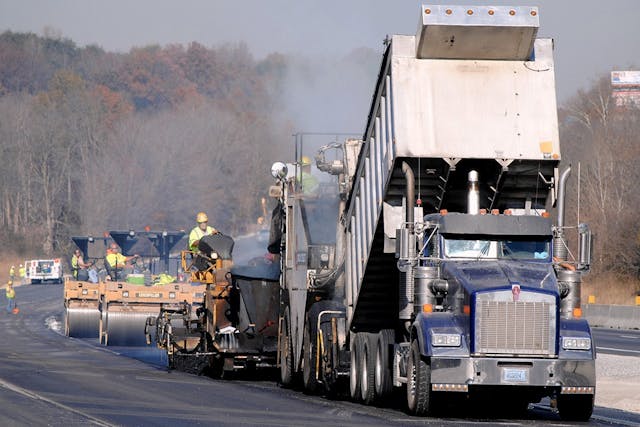Unlocking the Secrets of Hot Mix Asphalt Innovation
Checking out the depths of hot mix asphalt innovation discovers a world where precise processes and exact formulas assemble to shape our roads and infrastructure. The fusion of accumulations, fillers, and binders isn't simply a construction task yet a critical orchestration of longevity and effectiveness. As we peer into the elaborate dance of parts, a tapestry of resilience and sustainability unravels. Yet what exists below this surface of asphaltic proficiency, and what keys wait to be revealed in the realm of paving innovations?
Importance of Hot Mix Asphalt
Warm Mix Asphalt plays a critical role in modern-day facilities growth due to its longevity and cost-effectiveness. As the most generally used leading material for roads, freeways, and car park, Hot Mix Asphalt provides an array of benefits that add to its relevance in construction jobs. One vital advantage is its capability to hold up against heavy web traffic lots and harsh climate condition, providing a dependable and resilient surface area for transport networks. Additionally, Hot Mix Asphalt is affordable in both preliminary building and construction and lasting upkeep, making it a preferred option for lots of facilities tasks.
The resilience of Hot Mix Asphalt stems from its structure, which includes accumulations, binder, and filler materials that are meticulously chosen and mixed to satisfy certain performance requirements. This accurate combination causes a versatile and strong pavement that can sustain regular use without considerable wear and tear. Hot Mix Asphalt is 100% recyclable, further enhancing its sustainability and ecological advantages. In general, the significance of Warm Mix Asphalt in framework advancement can not be understated, as it proceeds to be a foundation of modern construction techniques.
Components of Asphalt Mixes
The structure of asphalt blends is composed of carefully chosen aggregates, binder, and filler products that are critical for achieving particular performance demands. Accumulations are the main element of asphalt blends, giving toughness and security. The binder, generally bitumen or asphalt cement, holds the aggregates together and offers versatility and resilience to the mix.
The mix and proportion of these parts play a significant function in figuring out the quality and performance of the asphalt mix. Designers carefully design the mix to meet specific needs, thinking about aspects like web traffic quantity, climate conditions, and pavement life expectancy. Appropriate choice and balancing of aggregates, binder, and fillers are important for developing resilient, lasting asphalt pavements.
Mixing and Manufacturing Strategies

As soon as the aggregates are selected, the binder, typically asphalt concrete, is included in bind the products with each other. The binder's top quality and amount dramatically influence the mix's versatility, stamina, and resistance to ecological variables. In addition, fillers like hydrated lime or Portland cement might be included to boost certain attributes of the asphalt mix, such as its workability or wetness resistance.
Throughout manufacturing, the aggregates and binder are heated, usually between 250-325 ° F(121-163 ° C ), to help with mixing and guarantee proper coating of the accumulations. The blending process must be extensive to attain an uniform mixture that advertises the desired efficiency attributes of the asphalt. Various strategies, such as set mixing or drum blending, are employed to attain constant and top quality asphalt blends for building projects.
Variables Impacting Asphalt Efficiency
Aspects influencing asphalt performance encompass a variety of variables that impact the longevity, longevity, and total quality of asphalt sidewalks. One key aspect is the quality of products made use of in the asphalt mix. The type and resource of aggregates, the binder high quality, and the ingredients all play a considerable duty in identifying the efficiency of the asphalt sidewalk. The gradation of accumulations is crucial as it impacts the mix's resistance, workability, and stability to rutting and cracking.

Environmental conditions additionally affect asphalt performance. Temperature level variants, wetness seepage, and web traffic loads can all affect the architectural stability of the pavement. Layout factors to consider, such as pavement density and drainage, are important in making certain the lasting performance of the asphalt sidewalk. By very carefully thinking about these engineers, service providers and elements can enhance asphalt efficiency and boost the service life of pavements.
Lasting Practices in Asphalt Modern Technology

WMA allows for the production and positioning of asphalt mixes at reduced temperature levels compared to typical hot-mix asphalt, resulting in decreased power consumption and greenhouse gas discharges. The usage of permeable asphalt mixes can aid mitigate stormwater overflow concerns by allowing water to penetrate via the pavement and into the ground, advertising natural water filtering and charge processes.
Conclusion
To conclude, hot mix asphalt innovation plays a crucial role in modern infrastructure advancement because of its longevity and cost-effectiveness. By thoroughly balancing elements, utilizing appropriate blending methods, and thinking about different aspects, designers can produce top notch asphalt blends that stand up to rush hour loads and severe climate condition. Embracing lasting techniques, such as making use of recycled products and warm-mix innovations, additionally improves the environmental kindness of asphalt modern technology.
Blending and production techniques in warm mix asphalt modern technology include the accurate mix and handling of aggregates, binder, and fillers to create a sturdy and high-performance asphalt mix.Elements influencing asphalt efficiency include a range of variables that influence the toughness, durability, and overall top quality of asphalt pavements. Lasting methods in asphalt technology incorporate different initiatives intended at decreasing the ecological effect of asphalt manufacturing and paving procedures. By incorporating redeemed asphalt pavement (RAP) and recycled asphalt tiles (RAS) into brand-new asphalt mixes, the sector can substantially reduce the intake of raw materials and power, while likewise lowering my website garbage dump waste.
WMA allows for the production and positioning of asphalt mixes at reduced temperatures compared to traditional hot-mix asphalt, resulting in lowered energy usage and greenhouse gas exhausts.
Comments on “Hot Mix Asphalt Paving: Elevating Commercial Parking Lot Requirements”